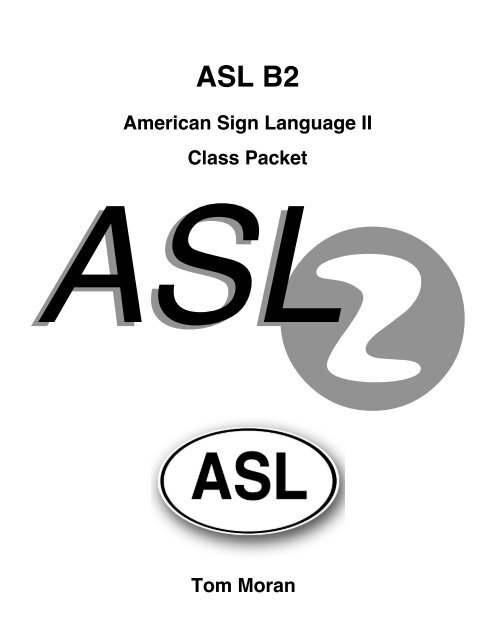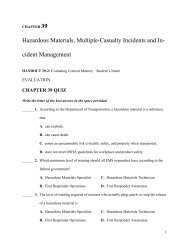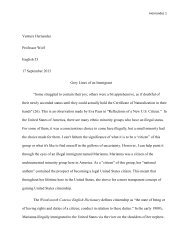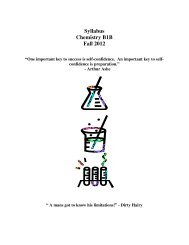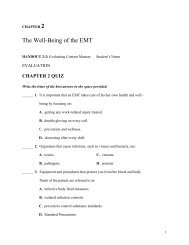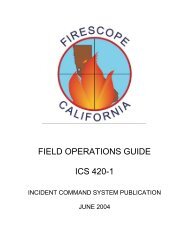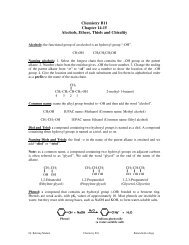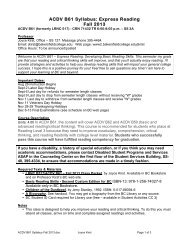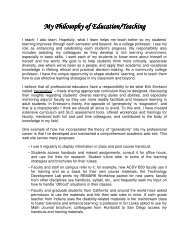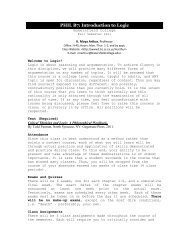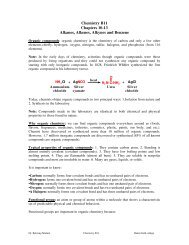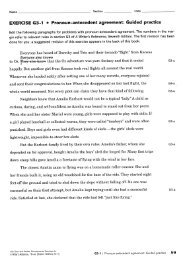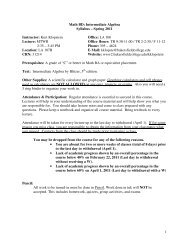ASL B2 American Sign Language II Class Packet - Bakersfield College
ASL B2 American Sign Language II Class Packet - Bakersfield College
ASL B2 American Sign Language II Class Packet - Bakersfield College
Create successful ePaper yourself
Turn your PDF publications into a flip-book with our unique Google optimized e-Paper software.
<strong>ASL</strong> <strong>B2</strong><strong>American</strong> <strong>Sign</strong> <strong>Language</strong> <strong>II</strong><strong>Class</strong> <strong>Packet</strong><strong>ASL</strong>2Tom Moran
Moran/<strong>ASL</strong> <strong>B2</strong><strong>ASL</strong> 1 <strong>Class</strong> <strong>Packet</strong> IndexAn Open Letter .....................................................................................3<strong>American</strong> <strong>Sign</strong> <strong>Language</strong> as a Foreign <strong>Language</strong> ..............................4Deaf Studies Terminology ....................................................................9<strong>Sign</strong>ing Naturally Curriculum ...........................................................13Fingerspelling in <strong>ASL</strong>..........................................................................16Fingerspelling RADAR .......................................................................17Deaf Community Interaction..............................................................18Deaf Community Event Report..........................................................19Minimal Pairs.......................................................................................20Spatial Agreement...............................................................................21Non-Manual Markers..........................................................................22<strong>ASL</strong> Conjunctions................................................................................23Commonly Fingerspelled Words.......................................................24Drawing Activity Sheets .....................................................................25Calendar Activity Sheets.....................................................................27Crossword Activity Sheet ...................................................................29Identify One Person Activity Sheets..................................................30Women’s Gym .....................................................................................33Drawing Activity Sheets <strong>II</strong>..................................................................34Street Scene ..........................................................................................38Hospital Room.....................................................................................39Guess the Relationship........................................................................40Hallway Activity Sheets......................................................................41Identify Patterns Activity Sheets........................................................43Daily Routines Activity Sheets...........................................................44Daily Who Does What Activity Sheet................................................45Survey Form.........................................................................................47Regional Quiz ......................................................................................482
Moran/<strong>ASL</strong> <strong>B2</strong>Dear <strong>ASL</strong> Enthusiast:Welcome to <strong>ASL</strong> 2. Prepare yourself to have fun and to learn a great deal. I willbe operating from the assumption that you passed <strong>ASL</strong> 1 very recently and have masteredthe concepts in that course. If I’m mistaken, please inform me right away, so that Ican assist you in getting up to speed.In the mean time, here are the five most important considerations for this course:1. Having completed <strong>ASL</strong> 1, you know that attendance is crucial. Be here.2. In order to learn <strong>ASL</strong>, you must participate. You also now know this is essential.3. If you haven’t been my student before, please know that everyone in my classwill treat one another with the utmost respect, including me:a. I won’t play favorites.b. I will assign you the grade you earn; nothing more, nothing less.4. I like to laugh and have fun. Let’s keep it that way.5. If you’re not sure about anything, ask—anytime.We are all students and we are all teachers. I expect that you will learn from me,and I expect to learn from you, too.I’m committed to your education and am prepared to help you in any way I can.I promise to support and encourage you, and that I will never belittle or humiliate you.If you’ve taken <strong>ASL</strong> with other teachers, you may see me do and sign things differentlythan they do. That’s good for you and will help your learning. There are other thingsthat will help your learning: work hard, be diligent, do more than the minimum required,help your classmates, and always be in class.I’m looking forward to traversing the semester with you.3
<strong>American</strong> <strong>Sign</strong> <strong>Language</strong> as a Foreign <strong>Language</strong>Sherman Wilcox, Ph.D, Associate ProfessorDepartment of Linguistics, University of New MexicoInterest in <strong>American</strong> <strong>Sign</strong> <strong>Language</strong> (<strong>ASL</strong>) as a foreign language has become, inthe words of Gary Olsen, former Executive Director of the National Association of theDeaf, "an <strong>American</strong> ground swell." Many colleges and universities are beginning to recognizethe study of <strong>ASL</strong> and Deaf culture as legitimate academic pursuits and arestarting to accept <strong>ASL</strong> in fulfillment of their foreign language entrance and exit requirements.In several states, <strong>ASL</strong> is mandated by law as acceptable in fulfillment ofhigh school foreign language graduation requirements.More and more colleges and universities are accepting <strong>ASL</strong> in fulfillment of foreignlanguage requirements. The University of California system (all campuses) willsoon accept <strong>ASL</strong> in fulfillment of foreign language entrance and graduation requirements.Harvard and Yale are among some of the schools which are investigating similaraction. Recently, we have witnessed tremendous activity by state legislatures to supportthe teaching and acceptance of <strong>ASL</strong> as a foreign language. Many states now recognize<strong>ASL</strong> as a foreign language for the purpose of meeting high school graduation requirements.In 1988, the parliament of the European Community, noting that there are500,000 profoundly deaf people in member states whose first language is their nationalsigned language and not the dominant spoken language of their country, recognized aslegitimate languages the indigenous signed languages of the twelve member states.Recognition and acceptance of signed languages is clearly an idea whose time has comeon an international scale.
Moran/<strong>ASL</strong> <strong>B2</strong>Many questions come to mind when the topic of <strong>ASL</strong> as a foreign language isbrought up. People often ask if it is appropriate to call <strong>ASL</strong> a foreign language. Is itreally a language? Isn't it a derivative of English, on the order of Black English? Is <strong>ASL</strong>"foreign"?—after all, it is used in the United States. Is there a body of literature associatedwith <strong>ASL</strong>? Others may note that foreign language courses teach students about theculture of the group of people who use the language. They may wonder if there is a fulland distinct culture associated with users of <strong>ASL</strong>.The answers to all of these questions support the recognition of <strong>ASL</strong> as a foreignlanguage. Because of its unique modality—visual/gestural rather than aural/oral—many people wrongly assume that <strong>ASL</strong> is fundamentally different than spoken languages.<strong>ASL</strong> is a fully developed human language, one of the hundreds of naturally occurringsigned languages of the world. It is not a derivative of English. It is not a "simplified"language—it contains structures and processes which English lacks (such as<strong>ASL</strong>'s rich verbal aspect and classifier systems). There is abundant linguistic research on<strong>ASL</strong> demonstrating that the grammar of <strong>ASL</strong> is radically different from English—surelyas different as any of the more traditional foreign languages taught in school. Comprehensivesources of information on the linguistics of <strong>ASL</strong> are Linguistics of <strong>American</strong> <strong>Sign</strong><strong>Language</strong> by Clayton Valli and Ceil Lucas (1993, Gallaudet University Press), <strong>American</strong><strong>Sign</strong> <strong>Language</strong>: Linguistic and Applied Dimensions by Ronnie Wilbur (1987, Little Brownand Co.) and The <strong>Sign</strong>s of <strong>Language</strong> by Edward Klima and Ursula Bellugi (1979, HarvardUniversity Press).The question of whether <strong>ASL</strong> is "foreign" depends on what we mean by foreign.<strong>ASL</strong> is not universal; it is indigenous to the United States and parts of Canada. Thisshould not, however, exclude it from study as a foreign language. The question alsoarises with other languages indigenous to North America. At the University of New5
Moran/<strong>ASL</strong> <strong>B2</strong>Mexico, for example, Navajo is taught and accepted in fulfillment of the foreign languagerequirement, yet it is not used in a foreign country. For reasons such as this,many language scholars now speak of second language, rather than foreign language,requirements.Some people may suggest that <strong>ASL</strong> lacks an international scope. In the hearingworld of international world affairs this is true. It is also true for many of the spokenlanguages traditionally accepted to fulfill foreign language requirements. On the otherhand, in the Deaf world, <strong>ASL</strong> is quite an important language on the international scene;for example, <strong>ASL</strong> is often an official language of international conferences.There is a rich body of <strong>ASL</strong> literature by and about Deaf people, as well as textson <strong>ASL</strong> in both written and oral modes. The folk heritage of Deaf people, passed downthrough generations of <strong>ASL</strong> users, includes legends, naming practices, tall tales, jokes,word play, games, poetry, customs, rituals, and celebrations. For more examples of theheritage and folklore of Deaf people, Jack Gannon's Deaf Heritage: A Narrative History ofDeaf America (1981, National Association of the Deaf) is an excellent resource.Foreign language study necessarily involves learning about the values, worldview,and way of life—the culture—of a group of people. The same is true for the studyof <strong>ASL</strong>. <strong>ASL</strong> students learn about the rich cultural life of Deaf people. Deaf culture isnow recognized and studied by anthropologists, ethnographers, folklorists, and othersinterested in culture and cross cultural communication. One excellent description ofDeaf culture is the recent book by Carol Padden and Tom Humphries, Deaf in America:Voices from a Culture (1988, Harvard University Press). <strong>American</strong> Deaf Culture: An Anthology,by Sherman Wilcox (Linstok Press, 1989), contains several articles presenting a varietyof perspectives on the language and culture of Deaf people in America. OliverSacks' recent book, Seeing Voices (University of California Press, 1989) is an introduction6
Moran/<strong>ASL</strong> <strong>B2</strong>to Deaf culture, <strong>ASL</strong>, and the struggle of Deaf people to gain control of their individualand community identity.The facts are overwhelming. <strong>ASL</strong> is a true human language fully distinct fromEnglish with its own literature and culture. It is important to go beyond these facts,however, and to ask whether, by offering <strong>ASL</strong> as a foreign language option, we do studentsan injustice by steering them away from courses which could be of more intellectualor economic value. Is <strong>ASL</strong> instruction a worthwhile addition to the curriculum?The answer clearly is "Yes—absolutely!" One of the educational benefits of foreignlanguage study is that it gives students a fresh perspective on their own languageand culture. This is especially true of <strong>ASL</strong>. Applying linguistic and anthropologicalmethods to the study of <strong>ASL</strong> and Deaf culture is an excellent intellectual exercise forstudents. It leaves them with a better understanding of another people's language andcustoms, as well as a deeper appreciation of their own language and culture.We do not teach languages only for the intellectual rewards. There are also practical,economic reasons for learning a foreign language. For example, our nation's businessesneed employees who can understand the language and customs of foreign people.This might seem to work against <strong>ASL</strong> because it is not associated with a foreign nationality.Again, the facts do not support such a contention. For example, students in thebachelor of science degree program in sign language interpreting at the University ofNew Mexico are regularly recruited into competitive positions in business, education,and government. Many students report that they take <strong>ASL</strong> specifically to make thembetter qualified or more employable in non-deafness related careers. Those studentswho want to continue their education at the graduate level find that a background in<strong>ASL</strong> opens up several avenues for advanced study and research.7
Moran/<strong>ASL</strong> <strong>B2</strong>Finally, some might wonder whether offering <strong>ASL</strong> as a foreign language optionwill cause a decline in enrollment in other foreign languages. The evidence from thoseuniversities which accept <strong>ASL</strong> as a foreign language is precisely the opposite. At theseuniversities there is no record of a decrease in traditional foreign language enrollmentdue to enrollments in <strong>ASL</strong>. As a matter of fact, <strong>ASL</strong> instruction may lead to increasedforeign language enrollment. <strong>ASL</strong> students often report that they are more interested inother languages—and indeed more likely to take a traditional, spoken foreign language—asa result of their <strong>ASL</strong> study. The joy of learning a new language and of communicatingwith people across cultural boundaries, it seems, is contagious!Students who know a foreign language commonly find that their perceptions ofthemselves and the world are richer than their monolingual peers. The study of a language,culture, and literature different than their own propels students beyond the limitsof their own world. In all respects <strong>ASL</strong> affords students the same challenges and rewardsas more traditional foreign languages.Copyright 1991 Sherman Wilcoxhttp://www.unm.edu/~wilcox/<strong>ASL</strong>FL/asl_fl.html8
Deaf Studies Terminology1. <strong>ASL</strong>: <strong>American</strong> <strong>Sign</strong> <strong>Language</strong>. The everyday language of nearly one million<strong>American</strong>s. It is commonly believed that <strong>ASL</strong> is the third most commonly used languagein the U.S., but this is not the case; however, it is a popular language. It isbased largely on French <strong>Sign</strong> <strong>Language</strong> (LSF) and was brought to the U.S. byLaurent Clerc, a French educator of Deaf children who partnered with Thomas Gallaudetto open the first public school for Deaf people in 1817.2. “Benevolent Paternalism”: A term coined by Harlan Lane, author of The Mask of Benevolence.It refers to the tendency of hearing people to see Deaf people as “lessthan” and in need of their assistance. This is often manifested in the low standardsin “deaf” education, multiple forms of signed English, religious evangelism targetingDeaf people, etc.3. Deaf: Note the capital “D”; this is the term is used to describe members of North<strong>American</strong> Deaf Culture. Note the capital “D,” which denotes a proper noun, muchin the same way you might refer to someone as “Chinese” or a “Black <strong>American</strong>.”Refer to people who have a hearing loss and are members of a culture as “Deaf people”or “people who are Deaf.” Never refer to them as “the Deaf” or in a mannersuch as “I saw a Deaf.”4. deaf: This term is used to describe an auditory pathology, that is the inability tohear, or hear well enough to transact a spoken conversation. The term “deaf” with alowercase “d” is used to describe the condition of deafness or a person who is not amember of <strong>American</strong> Deaf Culture.5. deaf and dumb: This is another opprobrious term from times gone by. Here theterm “dumb” means unable to speak; unfortunately, it’s homonym means “unintelligent.”Too often Deaf individuals are perceived of as unintelligent or incapable,
Moran/<strong>ASL</strong> 2and usually this is not the case. This was a very common term and you will see itstill, from time to time, in the media. Never use this term.6. Deaf Culture: See Deaf World.7. deaf-mute: This was a term popular up until the mid-20 th century. It is no longerused and has become opprobrious. It incorrectly describes people who are Deaf. Theinability to hear makes it very difficult to modulate one’s voice and to pronouncewords correctly; however, almost all Deaf people possess the power of speech.Rarely is a Deaf person actually “mute,” though many choose not to speak.8. Deaf World: This is a somewhat antiquated term, the way in which Deaf peopleused to refer to their collective experience: no telephones, residential schools, menialjobs, Deaf spouses, etc. Typically we now refer to the collective experience of North<strong>American</strong> Deaf people (and Deaf people from around the world) as Deaf Culture.9. death: For reasons that are a mystery to me, many students refer to Deaf people as“death.” While sometimes humorous (“I see deaf people. . . .”) it can be offensiveand make you look ignorant—which you are not. When people ask me if I workwith “the death,” I reply, “Yeth.”10. facial expressions: Facial expressions are emotive and universal. In every culturethe same facial expressions means, “OW! I just hit my thumb with a hammer,” or“Gee, I love you.” People who don’t understand sign language often confuse <strong>ASL</strong>’snon-manual grammar with emotive facial expressions, leading them to concludethat “<strong>ASL</strong> is SO expressive!”11. gesture: The use of movement to convey a message; more purposeful than bodylanguage, but not a language governed by a grammar. One uses basic inventedgestures to play that party game Charades. Someone who is skilled at gesture—like a10
Moran/<strong>ASL</strong> 2certified deaf interpreter—can communicate quite effectively with individuals whohave little expressive or receptive language.12. hearing: This is the term applied to people who have no hearing loss. Most of thestudents who take my class are hearing. Do not refer to hearing people as “speaking.”All too often people confuse the ability to speak with the ability to think or reason;on the contrary, if you listen talk radio, you will quickly learn that there is nolink between the ability to speak and the ability to think. Almost all Deaf people arecapable of speech but choose to sign as it is easier and more comfortable—in a word,natural.13. hearing impaired: Much has been said and written on the origin of this term. Somethink it is politically correct. Others think it is an economics term coined to talkabout 20,000,000 <strong>American</strong>s—many of them elderly—who have some significantform of hearing loss. It does not refer to members of a culture, and Deaf peoplerarely refer to themselves as “hearing impaired.”14. interpreter: An individual trained in interpreting and transliterating who is fluent inat least two languages, in our case English and <strong>ASL</strong>.15. MCE: Manually-Coded English. Whereas <strong>ASL</strong> is its own language, many people(most of them hearing) believe that if teachers sign in English word-order, withsymbols invented to mimic our syntax and phonology, Deaf students will improvetheir written English. This method has been tried since at least the early 18 th century.An experiment as old as deaf education itself, it is largely a failure.16. manual communication: Communicating using the hands and “body language.” Itscounterpart is verbal communication.17. non-manual behavior: A form of communication which is non-verbal as well asnon-manual, that is not on the hands. Non-manuals are movements of the face,11
Moran/<strong>ASL</strong> 2head, shoulders, and upper body which have grammatical meaning in <strong>ASL</strong>. For exampleif you tilt your head to your shoulder, you are indicating spatial or temporalimmediacy (he’s right there; she just left). If you raise your eyebrows, you are askinga yes/no question. Non-manual behaviors are sometimes referred to as the grammarof <strong>ASL</strong>.18. oralism: This is a method of instruction wherein a teacher mouths every word to aDeaf person and asks the Deaf person to learn to speak normally in spite of his inabilityto hear himself. A product of the Victorian age—and the preferred method ofinstruction in most countries around the world—it was standard procedure in theU.S. until the 1970s. There are schools who practice this method to this day. ManyDeaf people are raised and educated by the oral method. A vast majority of themturn to <strong>ASL</strong> at some point in their lives. I have never known a Deaf person to growup signing and later become oral.Pidgin <strong>Sign</strong>ed English: See “MCE”SEE: See “MCE”<strong>Sign</strong>ed English: See “MCE”signer: Someone who signs. Often you will see someone signing for a Deaf person in aclassroom or at a performance. While that individual is often referred to as a“signer,” he is actually an interpreter/transliterators. Interpreters actually interpretfrom one language into another language, <strong>ASL</strong> to English for example. Transliteratorstranslate from one language to another form of the same language, spoken Englishto signed English, for example.12
Moran/<strong>ASL</strong> 2The <strong>Sign</strong>ing Naturally CurriculumAs you know by now, the text we are using for this course is <strong>Sign</strong>ing Naturally,Level I. This is the book I use to teach both <strong>ASL</strong> 1 and <strong>ASL</strong> 2. For those students continuingin their studies, I use <strong>Sign</strong>ing Naturally, Level 2 for <strong>ASL</strong> 3, and portions of <strong>Sign</strong>ingNaturally Level <strong>II</strong>I for <strong>ASL</strong> 4 and beyond. I chose this text series carefully for a number ofreasons which I would like to share with you.1. Two of the three authors of this text series are Deaf; the hearing author is a CODA,the child of Deaf adults. All three are native users of <strong>ASL</strong>. Each is a pioneer in <strong>ASL</strong>instruction and they are teachers of <strong>ASL</strong> teachers. (It may interest you to know thatyour instructor has trained with them.) They are <strong>ASL</strong> interpreters, linguists, poets,and each has an advanced degree in language or linguistics.2. <strong>Sign</strong>ing Naturally is the best and most-widely used—by far—<strong>ASL</strong> text book available.If you came from a high school or college that offered <strong>ASL</strong>, you likely used thisbook. If you plan to transfer and continue your studies elsewhere, you will likely usethis textbook series. Among the colleges that use—and endorse—this text are GallaudetUniversity (in their Center on <strong>ASL</strong> Literacy), CSU Northridge, CSU Hayward.San Diego State University, and the University of California at San Diego, just toname a few.3. This text series uses the most modern second-language teaching methods. Whereasin the past <strong>ASL</strong> has been taught by listing vocabulary or transcribing English sentences,<strong>Sign</strong>ing Naturally uses a functional/notional approach. This means <strong>ASL</strong> istaught using <strong>ASL</strong>, emphasizing “communicative purpose” in the language we arestudying. It means <strong>ASL</strong> is taught emphasizing the functions of language use insituations students are likely to encounter outside the classroom.4. Finally, the <strong>Sign</strong>ing Naturally text series teaches <strong>ASL</strong> in a way that is respectful of<strong>ASL</strong> and members of Deaf culture. To begin with, it encourages a “no-voice” policy.13
Moran/<strong>ASL</strong> 2This can be unsettling to students who are not accustomed to guessing and feeling“off-balance” in a classroom; however, I assure you that it is the quickest and mosteffective way to learn <strong>ASL</strong>. In addition, <strong>Sign</strong>ing Naturally eschews the use of English“glosses” in labeling signs. A gloss (usually written in all caps, like CAT) is a label,printed in English, below the picture of a sign. While common sense would reasonthat this would enhance learning, the opposite is actually true. The overwhelmingmajority of signs can be translated into several, sometimes dozens, of different Englishwords. To label a sign with a single English word is to do a grave disservice toan <strong>ASL</strong> student, and leads students to asking such ignorant questions as “What’s thesign for ‘run,” where, in fact there are literally dozens of signs for that single Englishword, even more than there are definitions of that word.As you can tell, I think highly of this textbook series. I chose it to make both your lifeand my life easier, and because I think if you use this book to its fullest intent and if you studyhard, you will leave this class a competent, beginning <strong>ASL</strong> user who is comfortable conversingwith a stranger.14
Moran/<strong>ASL</strong> 2Fingerspelling in <strong>ASL</strong>Try reading the following paragraph quickly:The pweor of the hmuan mnidAoccdrnig to a rscheearch at Cmabrigde Uinervtisy, it deosn't mttaer in whatoredr the ltteers in a wrod are, the olny iprmoetnt tihng is taht the frist and lsat ltteer beat the rghit pclae. The rset can be a total mses and you can sitll raed it wouthit any porbelms.Tihs is bcuseae the huamn mnid deos not raed ervey lteter by istlef, but the wrodas a wlohe.Not that hard, is it? This demonstrates the fallacy of trying to see each letterwhen reading fingerspelled words. Many Deaf children—children not old enough toread—can understand many fingerspelled words. That’s because they recognize thewords as whole units, rather than as a series of letters. Being able to recognize all thewords in the above paragraph is an example of the three Cs of fingerspelling—Context,Clozure, and Configuration.Context: Once you determine the paragraph is a report on scientific research,that reduces the number of possible words you might encounter.Clozure: Because you see the first and last letter of each word in its proper place,it’s much easier to determine what the word is. Similarly, though you may miss some ofthe internal letters in a fingerspelled word, you can usually see the first and last letter.Configuration: The capitalized letters denote proper nouns (Cambridge University) aswell as the beginnings of sentences. Additionally, some words seems to have a unique“shape”: research, important, without, and whole. Even scrambled, these words stand out inthe paragraph.15
Moran/<strong>ASL</strong> 216ABABBACBADBAEBAFBAGBAHBAIBAJBAKBALBAMBANBAOBAPBAQBARBASBATBAWBAXBAYBAZBAUBAVBAGBAFingerspellingRADAR
Moran/<strong>ASL</strong> 2Deaf Community InteractionAs you know from your syllabus, interaction with members of the Deaf community is a requirementfor this course. It is a privilege to meet and share the company of Deaf people. Do so only when youare invited to. Respect the privacy and independence of Deaf people you meet and treat them as youwould have others treat you. As a general rule, don’t accost Deaf strangers in public and assume that theywill share your enthusiasm of <strong>ASL</strong>. At Deaf events, however, Deaf people are more than happy to communicatebriefly with you.To receive full credit toward your semester grade, you must complete 15 hours of interaction withthe Deaf community. I offer credit only for conversational interaction with Deaf people. Credit is notavailable for conversation with hearing classmates, for watching open-captioned movies, or for viewingvideotapes.You may attend any of the events listed on our website: .You may also find events on your own. Examples could be attending an event at the <strong>Bakersfield</strong> Club ofthe Deaf, a Deaf bowling league, an event at BGLAD, or even spending time with a Deaf classmate orcoworker. Your instructor must approve any of these self-generated interaction opportunities in advance—youwill not receive credit without approval. Please check to make sure that you are attending anevent that you, as a hearing <strong>ASL</strong> student, are invited to.In order to receive credit for interacting with the Deaf community, you must submit a one-pagewritten report (I prefer it be word-processed) about your interaction. Follow exactly the format on thefollowing page, “Deaf Community Event Report.” You may photocopy the page and fill it out, or youmay type it on a word processor copying the format as it is shown. You may also download this formfrom my website: IMPORTANT: To receive full credit, you must submit your report no later than the first classmeeting two weeks after having attended your event. If you turn it in later, I reserve the right to offerpartial or no credit. In addition, I will only accept Deaf Community Event Reports at the beginning ofclass. I have no interest in a report hastily scrawled during class when you should have been paying attentionto our exercises.I do double check reports periodically to see if, in fact, you were at the event. Should I discoverthat you have submitted a false report, you will lose ALL your Deaf community hours and will accept noothers from you for the remainder of the semester. This is a penalty equaling 1.5 letter grades, making itvirtually impossible to earn an A or a B in the course.Interacting with the Deaf community is a core component of this course because it is the best andmost enjoyable way for you to test your skills, to apply what you’ve learned in class, and to learn fromthe people whose language you are studying. While you will be exposed to—and learn about—DeafCulture, the primary reason for Deaf Community Hours is to support your language learning. Don’t beafraid to take chances, to learn something new, to have fun, and write a short account of that for me. Iassure you that you’ll have a great time.17
Moran/<strong>ASL</strong> 2Deaf Community Event ReportIf you attend an event that supplies a ticket, flyer, brochure, or other verification of attendance, you mustattach it to your report. If you need additional room you may write on the back or submit two pages.Name:Name of Event:Location of Event:Date of Event:Hours You Attended:Deaf Community EventReport is dueONE WEEK after youattend the event.1. Describe the event:2. What did you observe? For example, eye contact, mouthing, gesture vs. <strong>ASL</strong>, interaction betweenDeaf and hearing people, cultural behaviors. Write about one or two in detail.3. How do your observations relate to what you are learning in class?4. Additional comments or questions?18
Moran/<strong>ASL</strong> 2Minimal PairsThere are five parameters for almost every sign; they are1. Location2. Handshape3. Movement4. Palm Orientation5. Non-ManualA minimal pair is two signs that differ only by one parameter. Examples:Location: FUNNY – SUGAR Movement: VOTE – TEASEE – VOICEUGLY – DRY – SUMMERMISS – THINKFAKE-MOUSEMAKE – COFFEEFULL – ENOUGHHandshape: WHITE – LIKE Palm Orientation: THING – CHILDRENKNOW – THINKCAR – WHICHESTABLISH – APPT.SCHOOL – PROOFNon-Manual:NAKED – AVAILABLE19
Moran/<strong>ASL</strong> 2Spatial Agreement1. To show that a location or person is far away:a. Head: tiltedb. Eyes: squintedc. Mouth: open slightlyd. Index finger: trace route, extend arm fully2. To show that a location or person is at a moderate distance:a. Head: tiltedb. Eyes: normalc. Mouth: purse lips slightly, “mm”d. Index finger: trace route, extend arm moderately, about half way3. To show that a location or person is very near:a. Head: tilt to the dominant side with cheek almost touching raisedshoulderb. Eyes: wide openc. Mouth: teeth clenched, “cs”d. Index finger: trace route, keep hand close to body and no arm extension1.20
Moran/<strong>ASL</strong> 2Non-Manual MarkersAlso known as “Non-Manuals” (NMs), these facial expressions are not emotive; theyare grammatical. One’s eyebrows signal whether one is asking a yes/no question, aninformation question, or a rhetorical question. Generally, one does not “mouth” wordsas one signs (though there are exceptions), but one does convey adjectives and adverbswith mouth movements, also known as “mouth morphemes.” Other NMs include eyemovements, head tilt, and body shifts. Non-Manual Markers are the grammar of <strong>ASL</strong>.Yes/No QuestionsRaised eye browsWH Questionsa.k.a information QsLowered eye browsWHOWHATWHENWHEREWHYHOWRhetorical Questions—with answerRaised eye browsWHOWHATWHENWHEREWHYHOWA Few Mouth Morphemes:• cha: height, length, size• luch: jumbo, large• pah: finally• pow: explode, hit hard, hot temper• puh: tend, give in• bro: burned-out bulb, break, broke• ahh: far• th: not yet• pth: melt, smash• cs near (physically or temporally)• mm normal, relax, take time• ps-ps: fancy, chic• shh: wild time, make out21Adapted from and used with the permission of theCenter on <strong>ASL</strong> Literacy, Gallaudet University.
Moran/<strong>ASL</strong> 2<strong>ASL</strong> Conjunctions• FRUSTRATE (to be prevented from)• HIT (unexpectedly, turned out that)• FIND (find out that)• HAPPEN (happened that)• FINISH (then, completed)• WRONG 1 (without warning, suddenly)• WRONG 2 [movement – Y twisted] (plans being messed up)1. ME WALK WRONG 2 RAIN2. ME PLAN PARTY FIND HE CAN’T COME-HERE3. HE GO-AWAY VACATION 1-WEEK, HIT LAID-UP SICK4. ME CHAT HAPPEN HE-TELL-ME HE FROM BAKERSFIELD SAME-AS-ME5. TONIGHT TWO-OF-US WANT SEE MOVIE FRUSTRATE CLOSE6. SHE STINK DRAMA WRONG GOOD ACT7. HE STRUGGLE-HARD ESTABLISH NEW BUSINESS HIT SKYROCKET BUSINESS8. TWO-OF-THEM STEADY 6-MONTH WRONG 1 TWO-OF-THEM MARRY9. SHE RESEARCH #<strong>ASL</strong> HIT SHE FIND NEW RULE++10. DEBBIE GO-THERE STORE BUY #TTY HAPPEN #TTY SALE11. BABY SEEM SICK FIND BABY HAVE EAR INFECTION12. CLOTHES PUT-IN WASHING-MACHINE FRUSTRATE CLOTHES RUIN13. ME BUY NEW GLASSES WRONG 2 GLASSES DAMAGE14. TWO-OF-US CHAT FIND TWO-OF-US SAME HAVE DEAF SISTERS15. ME WATCH #TV WRONG #TV VAGUE16. PAUL DRIVE-THERE FRUSTRATE FRIEND NOT HOME17. BECKY GET NEW #CAR EXCITED FRUSTRATE #CAR STEAL18. PATTY HERSELF NOTHING-TO-IT WRONG 1 SHE SKYRISE FAMOUS22
Moran/<strong>ASL</strong> 2Commonly Fingerspelled Wordsphysical car related housing!fs-SICK! fs-(TOYOTA, CHEV) fs-GARAGEfs-FLU #CAR fs-ACfs-FEVER fs-VAN fs-PORCHfs-STIFF #BUS fs-DOORfs-HURT #SW fs-ROOFfs-CUT #TRUCK fs-SOFAfs-FOOT fs-USED fs-OWNERfs-DRUGS fs-AS-IS fs-OWNfs-NAIL fs-MPH fs-RENTfs-HAIR #OIL fs-SALEfs-DR fs-BRAKE fs-HOTEL#EEK fs-CLUTCH fs-APT#GASfs-REG (regular gas)fs-KEYSfs-LOCKfs-UNLOCKfs-CONDOfs-CABINfs-CITYfs-AVEfs-BLVDKEY: “fs” means fingerspelled. These words are typically spelled, not signed, in <strong>ASL</strong>.“#” denotes a lexicalized borrowing, what used to be known as a “loan sign.” These areformed fluidly and produced as signs, not words with discretely formed letters.23
24Moran/<strong>ASL</strong> 2
25Moran/<strong>ASL</strong> 2
26Moran/<strong>ASL</strong> 2
27Moran/<strong>ASL</strong> 2
Moran/<strong>ASL</strong> 21228
29Moran/<strong>ASL</strong> 2
30Moran/<strong>ASL</strong> 2
31Moran/<strong>ASL</strong> 2
32Moran/<strong>ASL</strong> 2
33Moran/<strong>ASL</strong> 2
34Moran/<strong>ASL</strong> 2
35Moran/<strong>ASL</strong> 2
36Moran/<strong>ASL</strong> 2
37Moran/<strong>ASL</strong> 2
38Moran/<strong>ASL</strong> 2
39Moran/<strong>ASL</strong> 2
40Moran/<strong>ASL</strong> 2
41Moran/<strong>ASL</strong> 2
42Moran/<strong>ASL</strong> 2
43Moran/<strong>ASL</strong> 2
44Moran/<strong>ASL</strong> 2
45Moran/<strong>ASL</strong> 2
46Moran/<strong>ASL</strong> 2
Moran/<strong>ASL</strong> 2Name:Regional QuizI will sign a series of sentences about people who live here in Kern County. After I signeach sentence, write the name of the person above the area that I say he or she lives in.Draw a circle around both the individual’s name and the town’s name. This quiz isworth 10 points.BettyExample:47


